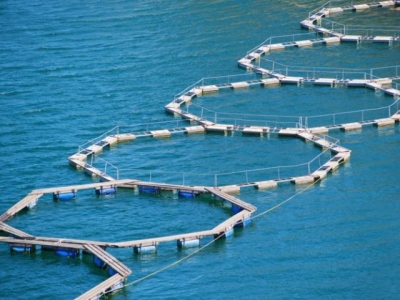Will farmed flathead grey mullet eat their vegetables, instead of fishmeal?

Switching fishmeal for plant proteins maintains growth and performance of farmed flathead grey mullet.
A group of international researchers examined transitioning wild caught fry to a farmed system and onto diets with low levels of fishmeal (FM). The group presented their results in the journal Aquaculture.
“This study aimed to test a weaning protocol for wild flathead grey mullet fry using compound diets with different levels of FM substitution by plant protein sources (50% and 75% of FM replacement by a blend of corn gluten, wheat gluten, soy bean meal and soy protein concentrate),” said the researchers in the study.
The group found that fish getting the replacement diets had similar responses in terms of growth performance, digestive physiology, proximate composition, and oxidative stress status as fish getting the fishmeal diet.
“A blend of PP [plant protein] sources as the main dietary protein sources in combination with crystalline l-lysine and dl-methionine dietary supplementation was equivalent to a FM-based diet in terms of growth performance, digestive physiology and fish condition, although a long term study is needed to confirm present results,” said the researchers.
Why plant proteins
Flathead grey mullet, is an important farmed species in several parts of the world including the Mediterranean, Korea, Taiwan and South Africa, said the researchers. It adapts to captivity, has an omnivorous diet and grows rapidly.
“Grey mullet is generally reared extensively in mono- or polyculture systems (Oren, 1981 and Biswas et al., 2012), but in order to supply an established market in the North of Africa and the growing demand in the Mediterranean area (Italy, Israel, Egypt, Tunisia), Asia and South Africa (Whitfield et al., 2012), the intensive monoculture of this species has to be developed,” they said. “This fact implies the development of a breeding technology and the development of a suitable and economical grow-out diet.”
Before establishing an industry-generated juvenile system, fry produced are wild caught, noted the team.
Little is known about the formulation of diets for farm-raised mullets, and items often used include microalgae, foraminiferans, filamentous algae, protists, meiofauna or small invertebrates, said the researchers. The ingredients used suggest that a diet could be successfully formulated with vegetable-based proteins to replace high levels of fishmeal.
However, some work has been done regarding replacing low amounts of fishmeal with algae-based diets, they said.
“Moreover, the use of the plant products is more economical and environmentally sustainable, which suggests that a focus on omnivorous and detritivorous fish species is needed,” said the team.
Previously, there have been concerns about using plant-based proteins in the diets of farmed mullet, said the researchers. However, improvements in fish nutrition have been made.
Experiment details
In the experiment, about 3,500 grey mullet fry were fed one of three experimental diets for a period of 60 days. The diets were formulated to offer 36% crude protein and 16% crude fat.
The diets included a control containing fishmeal (FM), a diet with 50% of the fishmeal replaced with plant protein (PP50) and one with 75% of the protein replaced (PP75), said the authors. “Although this is an omnivorous species (Whitfield et al., 2012), a diet based on the complete substitution of fish meal by plant protein sources was not taken into consideration since this species is carnivorous during the fry stage (Gisbert et al., 1995),” they added.
Fry were transitioned to the experimental diets during the first 20 days of the experiment.
Change in bodyweight (BW), standard length (SL) and condition was established at days 30 and 60, said the researchers. A selection of fish also was collected to check pancreatic and intestinal enzymes, histological organization, proximate composition, anti-oxidative stress response, lipid peroxidation levels and fatty acid and amino acid amounts.
Results
Similar responses were found for survival, growth performance and body condition among fish getting the three diets at both days 30 and 60, said the researchers. Additionally, a cost-benefit analysis of the diets showed the PP diets to be 15.5-23.6% cheaper depending on how much fishmeal was replaced.
The fatty acid profiles among the fish remained similar, with fish getting the PP supplements having higher levels of linoleic acid and there were no differences in amino acid profile, they said. Lipid peroxidation and anti-oxidative stress enzyme levels were the same.
Histological organization also was similar for fish on the different diets, they said.
“It is generally accepted that one of the major drawbacks associated to PP based diets is an impaired digestive capacity (Krogdahl et al., 1999, Santigosa et al., 2008, Silva et al., 2010 and Estévez et al., 2011), which in extreme cases may be associated to intestinal histopathological lesions (Uran et al., 2008 and Bansemer et al., 2015),” said the researchers. “In this study, the activity of pancreatic and intestinal digestive enzymes was not affected by the levels of FM substitution in diets.”
Có thể bạn quan tâm
 Does enzyme use ensure higher gain in tilapia production?
Does enzyme use ensure higher gain in tilapia production? Adding phytase to plant-derived tilapia diets may boost nutritional gain and offer improved growth performance and intestinal health.
 Supplemental selenium boosts plant-based aquafeed
Supplemental selenium boosts plant-based aquafeed Adding selenium to plant-based fishmeal may improve growth, performance of farmed seabass. Supplemental selenium boosts plant-based aquafeed
 Licorice feed additive boosts fish growth, immune response
Licorice feed additive boosts fish growth, immune response Adding licorice to farmed fish feed may improve immune response and boost growth performance.